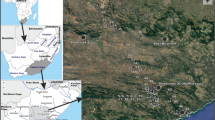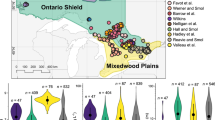Abstract
A calibration data set of 51 surface sediment samples from Lake Donggi Cona on the northeastern Tibetan Plateau was investigated to study the relationship between sub-fossil ostracod assemblages and water depth. Samples were collected over a depth range from 0.6 to 80 m. A total of 16 ostracod species was identified from the lake with about half of the species restricted to the Tibetan Plateau and its adjacent mountain ranges and poorly known in terms of ecological preferences, and the other half displaying a mainly Holarctic distribution. Living macrophytes and macroalgae were recorded in Lake Donggi Cona down to a depth of about 30 m, and bivalve (Pisidium cf. zugmayeri) and gastropod (Gyraulus, Radix) shells were found down to depths of 43 and 48 m, respectively. The ostracod-water-depth relationship was assessed by multivariate statistical analysis and ostracod-based transfer functions for water depth were constructed. Weighted averaging partial least squares (WA-PLS) regression provided the best model with a coefficient of determination r 2 of 0.91 between measured and ostracod-inferred water depth, a root mean square error of prediction of 8% and a maximum bias of 10.6% of the gradient length, as assessed by leave-one-out cross-validation. Our results show the potential of ostracods as palaeo-depth indicators in appropriate settings. However, transfer-function applications using fossil ostracod assemblages for palaeo-depth estimations require a thorough understanding of the palaeolimnological conditions of lakes and therefore detailed multi-proxy analysis to avoid misinterpretation of ostracod-based inferences.






Similar content being viewed by others
References
Alin SR, Cohen AS (2003) Lake-level history of Lake Tanganyika, East Africa, for the past 2500 years based on ostracode-inferred water-depth reconstruction. Palaeogeogr Palaeoclimatol Palaeoecol 199:31–49
Birks HJB (1995) Quantitative palaeoenvironmental reconstructions. In: Maddy D, Brew JS (eds) Statistical modelling of Quaternary science data. Technical Guide 5. Quaternary Research Association, Cambridge, pp 161–254
Birks HJB (1998) Numerical tools in quantitative palaeolimnology – progress, potentialities, and problems. J Paleolimnol 20:307–332
Bodergat A-M, Ikeya N (1988) Distribution of Recent Ostracoda in Ise and Mikawa bays, Pacific coast of central Japan. In: Hanai T, Ikeya N, Ishizaki K (eds) Evolutionary biology on Ostracoda. Ninth International Symposium on Ostracoda. Kodansha Ltd, Japan, pp 413–428
Boomer I, Horne DJ, Slipper IJ (2003) The use of ostracods in palaeoenvironmental studies, or what can you do with an ostracod shell? In: Park LE, Smith AJ (eds) Bridging the gap: trends in the ostracode biological and geological sciences. The Paleontological Society Special Publications. The Paleontological Society Papers, New Haven, pp 153–179
Boomer I, Horne DJ, Smith RJ (2006) Freshwater Ostracoda (Crustacea) from the Assynt region, NW Scotland: new Scottish records and a checklist of Scottish freshwater species. Bulletin de l’Institut Royal des Sciences Naturelles des Belgique, Biologie 76:111–123
Bößneck U (2009) Beitrag zu Verbreitung und Ökologie von Branchinecta orientalis (Sars 1901) in Nepal (Crustacea: Anostraca). In: Hartmann M., Weipert J (eds) Biodiversität und Naturausstattung im Himalaya III, Verein der Freunde und Förderer des Naturkundemuseums Erfurt e.V., Erfurt (in German with English Abstract) (in press)
Brooks SJ, Birks HJB (2000) Chironomid-inferred late-glacial and early-Holocene mean July air temperatures for Kråkenes Lake, western Norway. J Paleolimnol 23:77–89
Carbonel P, Colin JP, Danielopol DL, Löffler H, Neustrueva I (1988) Paleoecology of limnic ostracodes: a review of some major topics. Palaeogeogr Palaeoclimatol Palaeoecol 62:413–461
Cronin TM, Whatley R, Wood A, Tsukagoshi A, Ikeya N, Brouwers EM, Briggs WM Jr (1993) Microfaunal evidence for elevated Pliocene temperatures in the Arctic Ocean. Paleoceanogr 8:161–173
Danielopol DL, Geiger W, Tölderer-Farmer M, Orellana CP, Terrat MN (1988) In search of Cypris and Cythere – a report of the evolutionary ecological project on limnic Ostracoda from the Mondsee (Austria). In: Hanai T, Ikeya N, Ishizaki K (eds) Evolutionary biology of Ostracoda, its fundamental applications. Proceedings of the 9th International Symposium on Ostracoda. Kodasha and Elsevier, Tokyo and Amsterdam, pp 485–499
De Deckker P (1981) Ostracods of athalassic saline lakes. A review. Hydrobiologia 81:131–144
Delorme LD (1967) Freshwater ostracode synonyms. J Paleont 41:792–794
Delorme LD (1969) Ostracodes as Quaternary paleoecological indicators. Can J Earth Sci 6:1471–1476
Engstrom DR, Nelson SR (1991) Paleosalinity from trace metals in fossil ostracodes compared with observational records at Devils Lake, North Dakota, USA. Palaeogeogr Palaeoclimatol Palaeoecol 83:295–312
Forester RM (1986) Determination of the dissolved anion composition of ancient lakes from fossil ostracodes. Geology 14:796–798
Forester RM, Lowenstein TK, Spencer RJ (2005) An ostracode based paleolimnologic and paleohydrologic history of Death Valley: 200 to 0 ka. Geol Soc Am Bull 117:1379–1386
Hill MO, Gauch HG (1980) Detrended correspondence analysis: an improved ordination technique. Vegetatio 42:47–58
Horne DJ (2007) A mutual temperature range method for Quaternary palaeoclimatic analysis using European nonmarine Ostracoda. Quat Sci Rev 26:1398–1415
Juggins S (2003) User guide C2, Software for ecological and palaeoecological data analysis and visualisation, User guide Version 1.3. Department of Geography, Newcastle
Kempf EK, Scharf BW (1981) Lebende und fossile Muschelkrebse (Crustacea: Ostracoda) vom Laacher See. Mitt Pollichia 68:205–236
Kürschner H, Herzschuh U, Wagner D (2005) Phytosociological studies in the north-eastern Qinghai-Xizang Plateau (NW China) - A first contribution to the subalpine scrub and alpine meadow vegetation. Bot Jahrb Syst 126:273–315
Lister GS, Kelts K, Chen K, Yu J, Niessen F (1991) Lake Qinghai, China: closed-basin lake levels and the oxygen isotope record for Ostracoda since the latest Pleistocene. Palaeogeogr Palaeoclimatol Palaeoecol 84:141–162
Löffler H (1969) Recent and subfossil distribution of Cytherissa lacustris (Ostracoda) in Lake Constance. Mitt Int Verein theor angew Limnol 17:240–251
Meisch C (2000) Freshwater Ostracoda of western and Central Europe. Spektrum, Heidelberg
Mezquita F, Roca JR, Reed JM, Wansard G (2005) Quantifying species–environment relationships in non-marine Ostracoda for ecological and palaeoecological studies: examples using Iberian data. Palaeogeogr Palaeoclimatol Palaeoecol 225:93–117
Mischke S, Herzschuh U, Kürschner H, Fuchs D, Chen F, Meng F, Sun Z (2003) Sub-recent Ostracoda from Qilian Mountains (NW China) and their ecological significance. Limnologica 33:280–292
Mischke S, Herzschuh U, Zhang C, Bloemendal J, Riedel F (2005) A late Quaternary lake record from the Qilian Mountains (NW China): lake level and salinity changes inferred from sediment properties and ostracod assemblages. Glob Planet Change 46:337–359
Mischke S, Herzschuh U, Sun Z, Qiao Z, Sun N, Zander AM (2006) Middle Pleistocene Ostracoda from a large freshwater lake in the presently dry Qaidam Basin (NW China). J Micropal 25:57–64
Mischke S, Herzschuh U, Massmann G, Zhang C (2007) An ostracod-conductivity transfer function for Tibetan lakes. J Paleolimnol 38:509–524
Mischke S, Kramer M, Zhang C, Shang H, Herzschuh U, Erzinger J (2008) Reduced early Holocene moisture availability in the Bayan Har Mountains, northeastern Tibetan Plateau, inferred from a multi-proxy lake record. Palaeogeogr Palaeoclimatol Palaeoecol 267:59–76
Mischke S, Almogi-Labin A, Ortal R, Schwab MJ, Boomer I (2009) Quantitative reconstruction of lake conductivity in the Quaternary of the Near East using ostracods. J Paleolimnol. doi:10.1016/j.quaint.2009.03.002
Mourguiart P, Carbonel P (1994) A quantitative method of palaeolake-level reconstruction using ostracod assemblages: an example from the Bolivian Altiplano. Hydrobiologia 288:183–193
Mourguiart P, Correge T, Wirrmann D, Argollo J, Montenegro ME, Pourchet M, Carbonel P (1998) Holocene palaeohydrology of Lake Titicaca estimated from an ostracod-based transfer function. Palaeogeogr Palaeoclimatol Palaeoecol 143:51–72
Neale JW (1964) Some factors influencing the distribution of recent British Ostracoda. Pubbl Stn Zool Napoli 33:247–307
Neale JW (1988) Ostracods and palaeosalinity reconstructions. In: De Deckker P, Colin JP, Peypouquet JP (eds) Ostracoda in the Earth Sciences. Elsevier, Amsterdam, pp 125–155
Olander H, Birks HJB, Korhola A, Blom T (1999) An expanded calibration model for inferring lakewater and air temperatures from fossil midge assemblages in northern Fennoscandia. The Holocene 9:279–294
Prashad B (1933) Notes on Lamellibranchs in the Indian Museum–8. Species of the genus Pisidium from western Tibet, Yarkand, Persia and Syria. Rec Indian Mus 35:1–8
Rosenfeld A, Ortal R (1983) Ostracods as indicators of water pollution in Nahel Harod, northern Israel. In: Maddocks RF (ed) Applications of Ostracoda. University of Houston Geosc, Houston, pp 229–237
Savolainen I, Valtonen T (1983) Ostracods of the north-eastern Bothnian Bay and population dynamics of the principle species. Aquilo Ser Zool 22:69–76
Street-Perrott FA, Harrison SP (1985) Lake levels and climate reconstruction. In: Hecht AD (ed) Paleoclimate analysis and modeling. Wiley & Sons, New York, pp 291–340
ter Braak CJF, Juggins S (1993) Weighted averaging partial least squares regression (WA-PLS): an improved method for reconstructing environmental variables from species assemblages. Hydrobiologia 269/270:485–502
ter Braak CJF, Šmilauer P (1998) CANOCO reference manual and user’s guide to Canoco for windows: software for canonical community ordination. Microcomputer Power, Ithaca
Van der Woerd J, Tapponnier P, Ryerson FJ, Meriaux A-S, Meyer B, Gaudemer Y, Finkel RC, Caffee MW, Zhao G, Xu Z (2002) Uniform postglacial slip-rate along the central 600 km of the Kunlun Fault (Tibet), from 26Al, 10Be, and 14C dating of riser offsets, and climatic origin of the regional morphology. Geophys J Int 148:356–388
Viehberg FA (2005) Quantitative paleoenvironmental studies using freshwater ostracods in northeast Germany. Unpublished PhD thesis, Ernst Moritz Arndt University Greifswald, 144 pp
Viehberg FA (2006) Freshwater ostracod assemblages and their relationship to environmental variables in waters from northeast Germany. Hydrobiologia 571:213–224
Wang Y, Yang H (2004) Middle Permian palaeobiogeography study in East Kunlun, A’nyêmaqên and Bayan Har. Sci China Ser D Earth Sci 47:1120–1126
Yang J-S, Robinson PT, Jiang C-F, Xu Z-Q (1996) Ophiolites of the Kunlun Mountains, China and their tectonic implications. Tectonophysics 258:215–231
Yang F, Sun Z, Qiao Z, Zhang Y (2004) Revision of the diagnosis of the genus Qinghaicypris Huang, 1979 (Ostracoda) and the environmental significance of its type species. Acta Micropal Sin 21:367–381 (in Chinese with English abstract)
Yin Y, Martens K (1997) On a new species of Fabaeformiscandona Krstic 1972 (Crustacea, Ostracoda) from China, with a preliminary checklist of Recent Chinese non-marine ostracods. Hydrobiologia 357:117–128
Acknowledgments
We like to thank Jianhui Chen, Yanyun Ji, Conrad Kopsch, Xiaolong Liu, Andreas Plank, Qili Yang and Sizhong Yang for help during fieldwork. Marjaana Lieb kindly performed the mollusk shell counting. Ian Boomer, Jonathan Holmes and an anonymous referee provided many constructive and thoughtful comments which helped to improve the manuscript. In addition, the journal editor Thomas J Whitmore made many helpful corrections and suggestion to improve the clarity of the manuscript. Part of the work reported here was conducted at the Limnological Research Center (LRC) of the University of Minnesota (USA) while S.M. was in receipt of a research fellowship of the German Research Foundation, and he would like to thank Emi Ito and other members of the LRC for their kind hospitality during his visit. In addition, S.M. is indebted to Emi Ito for critical comments concerning the application potentials of the presented transfer function. Amy Myrbo provided many editorial comments which helped to improve the manuscript. Funding for the work at Lake Donggi Cona was provided by the Alfred Wegener Institute for Polar and Marine Research, Research Unit Potsdam, and the German Research Foundation (Deutsche Forschungsgemeinschaft, DFG).
Author information
Authors and Affiliations
Corresponding author
Rights and permissions
About this article
Cite this article
Mischke, S., Bößneck, U., Diekmann, B. et al. Quantitative relationship between water-depth and sub-fossil ostracod assemblages in Lake Donggi Cona, Qinghai Province, China. J Paleolimnol 43, 589–608 (2010). https://doi.org/10.1007/s10933-009-9355-2
Received:
Accepted:
Published:
Issue Date:
DOI: https://doi.org/10.1007/s10933-009-9355-2




